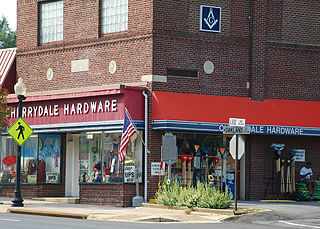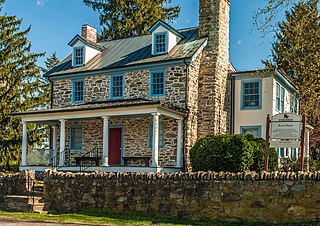
Barton Heights is a streetcar suburb neighborhood and former town in the Northside area of Richmond, Virginia. The area was primarily developed between 1890 and the 1920s.

Southwest Mountains Rural Historic District is a national historic district located near Keswick, Albemarle County, Virginia. The district encompasses 854 contributing buildings, 73 contributing sites, 30 contributing structures, and 1 contributing object. It includes a variety of large farms, historic villages, and crossroads communities. The area is known primarily for its large and imposing Federal, Greek Revival, and Georgian Revival plantation houses and country estates. It features a broad range of architecture—mainly domestic and farm-related—from the late 18th, 19th, and 20th centuries.

The Glencarlyn Historic District is a national historic district located in the Glencarlyn neighborhood of Arlington County, Virginia. It contains 276 contributing buildings, two contributing sites, one contributing structure, and one contributing object in a residential neighborhood in South Arlington. The area was platted in 1887 as Carlin Springs and continued to develop throughout the 20th century as a residential subdivision. The dwelling styles include a variety of architectural styles, ranging from Craftsman-style bungalows, Colonial Revival–style, and Queen Anne style dwellings. Notable buildings and sites include the Carlin Family Cemetery, Glencarlyn Library, and St. John's Episcopal Church. Also located in the district are the separately listed Ball-Sellers House and Carlin Hall.

The Cherrydale Historic District is a national historic district located in the Cherrydale neighborhood of Arlington County, Virginia. It contains 948 contributing buildings, 1 contributing site, 2 contributing structures, and 1 contributing object in a residential neighborhood in northern Arlington. The area was platted in 1898, with the majority of dwellings constructed in the second quarter of the 20th century. The dwelling styles include a variety of architectural styles, including a number of Colonial Revival and Queen Anne style dwellings. Also located in the district is the separately listed Cherrydale Volunteer Fire House.

Middlebrook Historic District is a national historic district located at Middlebrook, Augusta County, Virginia, United States. It encompasses 50 contributing buildings and 52 contributing sites in the rural village of Middlebrook. Most of the buildings along the main street date to the 19th century. It primarily consists of vernacular houses and commercial buildings. Non-residential buildings include five stores, a frame school building, two churches, an Odd Fellows Hall, and a shoemaker's shop.

Cifax Rural Historic District is a national historic district located near Cifax, Bedford County, Virginia. It encompasses 51 contributing buildings, 7 contributing sites, and 2 contributing structures. The district includes the dwellings and outbuildings of prominent families, the houses of the poor and middling farmers and the laborers who in part depended on them for employment, and the stores, schools, and churches that served them. Notable buildings include the Dillard-Coffey House, Logwood-Williams House, Old Nazareth Methodist Episcopal Church, Poplar Springs Baptist Church, Cifax School, The Cedars, Noell-Lankford House, Poindexter-Ellett-Higginbotham Farm, and Glen Alpine designed by architect Pendleton S. Clark with landscaping by Charles F. Gillette.

Beach Station a national historic district located near Chesterfield, in Chesterfield County, Virginia. The district includes six contributing buildings and one contributing site in the Village of Beach. They were all constructed about 1890 and are two single-family dwellings, a post office, a railway depot, an outbuilding, two railroad shanties, and the ruins of the former general store. Beach Station was accessible from the Farmville and Powhatan Railroad later named the Tidewater and Western Railroad. Leasing arrangements had been made with the Brighthope Railway company which was sold to become the Farmville and Powhatan. The district represents an unusual collection of late-nineteenth-century buildings in their historic surroundings. It was listed on the National Register of Historic Places in 2008.

Greenway Historic District is a national historic district located near Boyce, Clarke County, Virginia. It encompasses 432 contributing buildings, 23 contributing sites, and 35 contributing structures. The districts includes the agricultural landscape and architectural resources of an area distinctively rural that contains numerous large antebellum estates. The district contributing buildings are primarily farm and estate residences and their associated outbuildings. Other contributing buildings include three schools, five churches, two mills, a gas station, a restaurant, and a railroad station. The contributing structures are mostly corncribs and the contributing sites are mainly cemeteries and ruins of historic buildings. The district contains ten individual properties and two historic districts already listed on the Virginia Landmarks Register and National Register of Historic Places.

Long Marsh Run Rural Historic District is a national historic district located just outside Berryville, in Clarke County, Virginia. It encompasses 315 contributing buildings, 16 contributing sites, and 35 contributing structures. The district includes the agricultural landscape and architectural resources of an area distinctively rural that contains numerous large antebellum and postbellum estates, and several smaller 19th-century farms, churches, schools and African-American communities.

Atoka Historic District is a national historic district located at Atoka, Fauquier County, Virginia. It encompasses 11 contributing buildings in the rural crossroads of Atoka. They include four dwellings and their various outbuildings, two commercial buildings, and a stone spring house. Notable buildings include the Caleb Rector House, the Atoka Store, and the Rector-Deane House (1893).

Ashville Historic District is a national historic district located near Marshall, Fauquier County, Virginia. It encompasses 16 contributing buildings and 1 contributing site in the Reconstruction-era African-American rural village of Ashville. The district contains nine properties, including the Gothic Revival style Ashville Baptist Church (1899), Ashville School (1910s), Ashville Community Cemetery, and a concentration of historic dwellings and related outbuildings.

Morgantown Historic District is a national historic district located near Marshall, Fauquier County, Virginia. It encompasses 7 contributing buildings and 2 contributing sites in the Reconstruction-era African-American rural village of Morgantown. The district contains four dwellings, the Mount Nebo Baptist Church (1902), an abandoned Morgantown School, a meat house, the ruins of an outbuilding, and a cemetery.

Orlean Historic District is a national historic district located at Orlean, Fauquier County, Virginia. It encompasses 51 contributing buildings and 2 contributing sites in the rural village of Orlean. The district includes commercial buildings, churches, a post office, a former school, and multiple residences and their ancillary outbuildings that date from the late 18th century to the mid-20th century. Notable buildings include the Orlean Farm House, Smith-Hinkley House, the Anderson-Rector House and Store, the Greek Revival style Thorpe-Cornwell House, Jeffries Store (1885), Orlean Methodist Church (1881-1883), Providence Baptist Church (1883), and Orlean post office building (1956).

Newport Historic District is a national historic district located at Newport, Giles County, Virginia. It encompasses 50 contributing buildings and 3 contributing sites in the rural village of Newport. The district includes primarily freestanding single-family dwellings or store buildings of one or two stories, featuring wood-frame construction, wood siding or ornamental metal sheathing, front porches, and associated outbuildings. Notable buildings include the Epling-Dunkley[or Dunklee]-Smith House (1820s-1830s), Keister-Miller House (1846), Robert Payne House (1850s), Payne-Price House, the Miller Building, the Pent Taylor Store, the Miller Brothers General Mercantile Store, F.E. Dunkley [Dunklee] Store, Pasterfield House (1903), Dr. Walter Miller House (1903-1904), Albert Price House (1904), Methodist Parsonage (1909), Newport Methodist Church, and Sinking Creek Valley Bank (1927).

Heathsville Historic District is a national historic district located at Heathsville, Northumberland County, Virginia. The district includes 81 contributing buildings, 12 contributing sites, 4 contributing structures, and 4 contributing objects in the county seat of Northumberland County. It is an assemblage of residential, commercial, and government buildings dating from the 18th through 20th centuries in a variety of popular architectural styles. The linear district is centered on the courthouse square. Notable buildings include the Northumberland Court House, the old county jail (1844), the former Methodist Protestant Church, Harding House, Belleville, Heathsville Masonic Lodge No. 109 (1894), Bank of Northumberland (1924), and the Heathsville United Methodist Church (1894). Located in the district and separately listed are Rice's Hotel, Oakley, St. Stephen's Church, Sunnyside, and The Academy.

Prince George County Courthouse Historic District is a county courthouse complex and national historic district located at Prince George, Prince George County, Virginia. The district includes 11 contributing buildings and 3 contributing objects. They include the 1883 courthouse, 1900 clerk's office, the jail dated to about 1900, and three mid 20th century Colonial Revival-style office buildings. A Craftsman-style dwelling was adapted for office use and added to the courts complex in the 1970s. The courthouse green includes memorials commemorating the Civil War, World Wars I and II, and the Korean and Vietnam Wars. Also included in the district are the F.L. Buren Store, the Victorian-style Buren residence, and two contributing outbuildings.

Brentsville Historic District is a national historic district located near Bristow, at Brentsville, Prince William County, Virginia. It encompasses 23 contributing buildings and 2 contributing sites in the village of Brentsville platted in 1822. These include the former Brentsville Courthouse and Jail, a one-room school (1928), three churches, 11 houses, one ruins of a dwelling, a tavern square site, and 14 outbuildings.

Edinburg Historic District is a national historic district located at Edinburg, Shenandoah County, Virginia. The district encompasses 292 contributing buildings, 6 contributing sites, 3 contributing structures, and 3 contributing objects in the town of Edinburg. It includes a variety of commercial, residential, and institutional buildings dating primarily from the time of its incorporation in 1852 to the mid-20th century. They are in a variety of popular architectural styles including Colonial Revival, Italianate, and Queen Anne. Notable buildings include the Philip Grandstaff House (1787), Edinburg Hotel, St. John's United Methodist Church (1916), Edinburg High School (1932-1933), Rush House, The Hatch, Piccadilly House (1850), Pres Grandstaff House, Masonic Building (1879), Harshman House (1900), Rest Haven Inn, Edinburg Train Station, Edinburg Village Shops (1896), Wrenn Building, Edinburg Town Hall (1903), St. Paul's United Church of Christ (1911), and the Mantz House (1930). Located in the district is the separately listed Edinburg Mill.

Marion Historic District is a national historic district located at Marion, Smyth County, Virginia. The district includes 361 contributing buildings, 2 contributing sites, and 1 contributing object in the central business district and surrounding residential areas of Marion. It includes a variety of residential, commercial, institutional, industrial, and governmental buildings primarily dating from the mid-19th to mid-20th centuries. Notable buildings include the Sheffey Loom House, Odd Fellows Lodge, Look & Lincoln Wagon Factory warehouse, the Beaux-Arts style Marion County Courthouse (1905), Mt. Pleasant Methodist Church, Courtview Building (1890s), Marion High School (1907-1908), Marion Junior College (1912), the Overall Factory, Weiler Building, Bank of Marion (1922), Royal Oak Presbyterian Church (1923), Marion Municipal Building (1935), Marion Post Office (1936), and a Lustron house (1948). Also located in the district are the separately listed Hotel Lincoln, Lincoln Theatre, Marion Male Academy, and Norfolk & Western Railway Depot.

Downtown Salem Historic District is a national historic district located at Salem, Virginia. The district encompasses 34 contributing buildings and 1 contributing site in downtown Salem. The district includes primarily mixed-use commercial buildings, but also includes churches, dwellings, a courthouse, a post office, a library, a park, and the covered stalls of a farmer's market. The buildings mostly date from the late-19th and early-20th century and are in a variety of popular architectural styles including Greek Revival, Italianate, and Queen Anne. Notable buildings include the Stevens House or "Old Post House" (1820s-1830s), Kizer-Webber Building (1883-1886), Duval-Oakey House (1891-1898), Salem High School, Old Salem Municipal Building and Fire Department (1925), Quality Bakery Building, Olde Newberry Building (1929), Salem Theater, and James J. True Building (1927). Located in the district are the separately listed Old Roanoke County Courthouse, Salem Presbyterian Church, and Salem Post Office.

























